The Ink-Stained Amazon Presents From Helen to Hit Girl
Jennifer K. Stuller on August 1, 2010 in UncategorizedOne of the many highlights of my trip to Comic-Con 2010 was getting to sit on the Where are the Action Chicks? panel for the Comic Arts Conference.
Moderator and organizer, Katrina Hill asked me to provide a 10 minute history of action heroines in film and television (which I pushed to 13 minutes to include a short video). The script and slides are here for your pleasure, sans special effects, of course. If you’d like to know more, may I suggest a copy of Ink-Stained Amazons and Cinematic Warriors: Superwomen in Modern Mythology?
A Brief History of Action Heroines in Film and Television for the “Where Are The Action Chicks?” Panel Comic-Con 2010, CAC.
Katrina asked me to provide a 10 minute presentation on the History of Action Heroines in film and television. So keeping in mind that this will be brief, brief, VERY brief, buckle up, and hold on to your hats for “From Helen to Hit-Girl!”
Audiences love Ass-kicking Babes and Gun-toting Warrior Women. And yet, action heroines are O-Ver-Whelm-ing-ly outnumbered by action men.
We know popular culture both reflects and influences social mores. That American women’s roles have evolved, and in fact, female and male roles have changed. Yet many modern hero stories, like those of classic world myth, continue to privilege male experience and fantasy; while women in these stories, regardless of how kick-ass, capable, smart, or skilled they may be, are typically limited to the supporting roles of love interests, temptresses, and sidekicks.
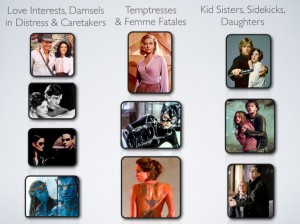
Women, of course, can be these things, but we can also be more.
As the title of this panel rightly asks, “Where are the Action Chicks?”
There were few action heroines in American film and television until the mid-twentieth century. An early example, however, is stuntwoman Helen Holmes, who starred as the eponymous daredevil in the long-running silent film serial The Hazards of Helen. Though the latter films starred Helen Gibson, she was just as noted for her daring as her predecessor.
Jumping forward a few decades – and across the pond – to 1960s era Britain, where Dr. Catherine Gale & Mrs. Emma Peel of the television series, The Avengers, and the unparalleled, Modesty Blaise, proved that popular culture was primed for female adventurers of independence and sexual sophistication.
Honor Blackman starred as Cathy Gale, and at the time, noted that she was a first for television – a feminist academic anthropologist in black boots, leather suits, and who’d kick your ass with judo.
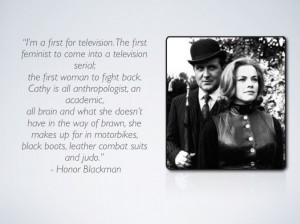
When Blackman left the series to star in the James Bond film, Goldfinger, Diana Rigg was brought in to portray Mrs. Emma Peel. Fashionable, witty, and charming, Mrs. Peel was a delightful intellectual, and could more than hold her own in a fight.
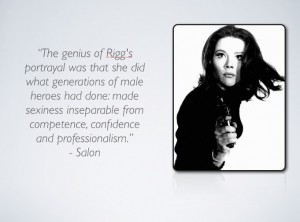
Even when upside down in gravity boots.
She was also the model for the Diana Prince era of Wonder Woman.
Modesty Blaise, was the star of a daily comic strip that ran for nearly forty years, as well as the heroine of 13 books. She was also the subject of one terrible movie and one mediocre one – the less said about these the better. Regardless, Modesty – highly trained, resourceful, compassionate – and the leader of a global crime syndicate before retiring in her mid-20s, remains one of the coolest, most complex, and intriguing characters of all time.
And she has been influential on subsequent action and super heroines.
Honey West was the first female action hero on American television. Anne Francis starred as Honey – a sexy, tough-cookie private investigator that ran her own detective agency and in an all-too-rare reversal of gender roles, had a male sidekick who deferred to her authority.
In the United States, action heroines’ popularity in the late 1960s and through the 1970s was facilitated by second-wave feminism, and the momentum of the political movement afforded kick-ass female characters a timely marketability.
But it was Lynda Carter’s lovely and graceful embodiment of the iconic Wonder Woman that inspired so many of us, to get up out of our seats and twirl along with her as she magically transformed from her alias to her true Amazonian identity.
Joining Wonder Woman were Police Woman, the Bionic Woman and Charlie’s Angels. Though these action heroines were awesome, television series in the 1970s walked a slippery line between embracing real women’s changing roles and maintaining normative ideas about femininity. Female leads presented conventional notions of beauty: white, athletic, and more often than not, blonde.
In fact, in the 1970s the only action heroine of color in a leading role on television was Teresa Graves’ Christie Love in Get Christie Love.
Some of the most influential, and at the very least memorable, action heroines can be found in unconventional genres. Low-budget and exploitation films in the 1960s and 1970s presented a paradoxical combination of exploitation and empowerment with results that are as repressive as they are subversive.
Tura Satana’s Varla in Faster, Pussycat! Kill! Kill! is the leader of a girl gang, drives fast, knows karate, is empowered sexually, but is essentially a villainess.
Jane Fonda’s Barbarella, is an independent space traveler as secure in exploring the final frontier as she is her sexuality. But our nearly-naked heroine frequently requires rescue.
Mary Woronov starred as bad-ass race car driver Calamity Jane in the cult classic, Death Race 2000. But she dies.
And The Doll Squad – about a group of awesome female commandos – is totally ridiculous.
Blaxploitation films, particularly those of Pam Grier, presented a type of warrior woman never seen before. Her tough, independent heroines protected their communities, with brains as well as guns, and exacted vengeance against those who wronged them or their loved ones.
Blaxploitation is also one of the few places where we find women of color in action heroine roles –
– that is, of course, outside of martial arts cinema.
In the 1980s, conservative politics and media resulted in a backlash against the feminist movement and strides women had made in the previous decade. Popular culture, again privileged masculinity – emphasizing it even, as action heroines were overshadowed by muscular action men, and women in film and television were all too often resituated in more gender normative roles by their story’s end.
Notable examples of this include Princess Leia of the Star Wars trilogy, who began her story as a rebel leader but by the end was merely a sister and love interest.
Valeria – the glorious, sinewy warrior-woman played by, Sandahl Bergman, in Conan the Barbarian – is an independent thief and glorious bad-ass turned love interest who sacrifices her life for that of the hero.
Brigitte Nielsen’s Red Sonja is a master swordswoman who through her adventures becomes a mother figure and is repeatedly told to be nicer to men, because, you know, she needs their help or something.
Others include Erin Grey’s Col. Wilma Deering on Buck Rogers. Faye Grant’s Dr. Julie Parrish of the mini and television series, V. And Supergirl. She was played with such conviction and grace by the lovely Helen Slater, but sadly, ultimately, our heroine’s adventure revolved around a catfight with a cougar for the affections of a man.
1984’s B-movie classic, Night of the Comet is a genre mash-up of horror, sci-fi, and comedy, about sisters Sam and Reggie – sassy, smart teenagers who kick zombie ass in a post-apocalyptic SoCal. And, they served as inspiration for Joss Whedon’s Buffy Summers.
Despite the privileging of muscle men one of the most memorable heroines of all time emerged in Sigourney Weaver’s Lt. Ellen Ripley.
Though the character had appeared in 1979’s Alien, it was in the sequel – that Ripley took center stage. As with other action heroines, Ripley adopted and protected a child. But this in no way softened her character, and said child, Carrie Henn’s “Newt,” is an action hero in her own right – having survived alone for weeks on an alien infested planet. Aliens also featured a third action heroine of note in Jenette Goldstein’s Private Vasquez – a butch Latina Marine that is braver and fiercer than her male comrades.
Grrrl Power and adult culture makers influenced by second wave parents, facilitated some of the most complex women of popular culture to date. And in the 1990s, entertainment media once again reflected liberatory ideas about what women were capable of accomplishing.
The first of these was Sarah Connor of 1991’s Terminator 2: Judgment Day. The character had evolved from her first incarnation as a waitress to a full-fledged warrior. Reinforcing this was the fact that Linda Hamilton’s physical transformation was nothing short of revolutionary.
Aeon Flux – a lawless assassin that first appeared on MTV – remains as startling, subversive, and disturbing as she was 20 years ago.
Xena, a former warlord on a quest for redemption, and her companion Gabrielle, a farm girl turned Warrior Bard, kicked ass and had a playful, loving, and complex partnership that made them LGBTQ icons.
Special Agent Dana Scully of The X-Files proved that an action heroine could be a doctor and a scientist.
Perhaps the most influential action heroine of the decade, and certainly the one with the most lasting influence, is Buffy Summers, of Joss Whedon’s seminal television series, Buffy the Vampire Slayer.
She was embodied by Sarah Michelle Gellar, and created with the intention of being a feminist role model, but since I could go on for hours about her, it is best to move on.
The success of Buffy inspired a wave of action heroines in both film and television – some, like Alias’ Sydney Bristow, were more successful than others.
Quite a few seemed to travel in packs of three.
And only one, Dark Angel, featured a lead protagonist of color in Jessica Alba’s Max Guevara.
Additionally, the current Dr. Who has seen a number of complex action heroines over the past 5 years.
And the revisioned Battlestar Galactica recast two prominent male roles from the original with women.
Most recently, Hit-Girl, a film heroine we’ll be talking about for a good while, received critical responses ranging from the New York Times saying that the character gives the false impression that because she’s a powerful figure she’s also an empowering one. To another critic championing her as “one of cinema’s few female characters who is meant to be admired for being stronger, braver, and more heroic than the male characters around her.”
Finally, a visual representation of action heroines in film and television I didn’t mention today doesn’t quite have the same impact as our earlier slide of male heroes.
(Then here I show my awesome video of female heroes kicking ass and set to “Battle without Honor or Humility.” If you want to see it, you’ll just have to come see my next book reading!)
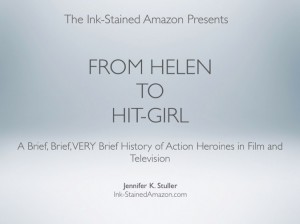
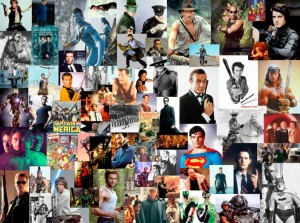
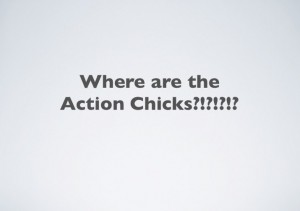

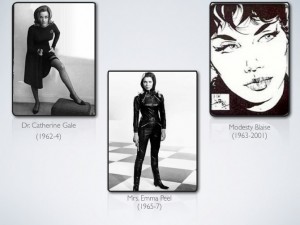


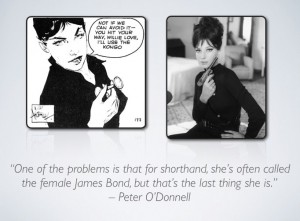
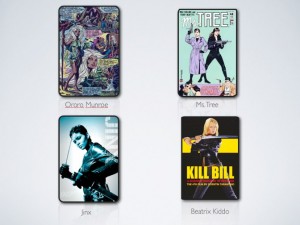
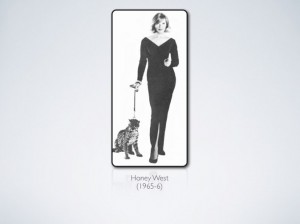
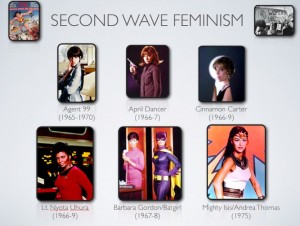
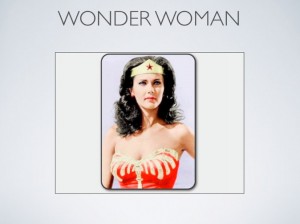
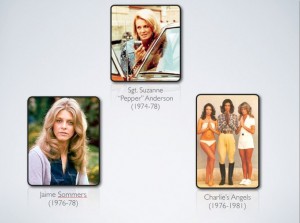
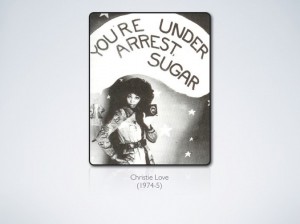
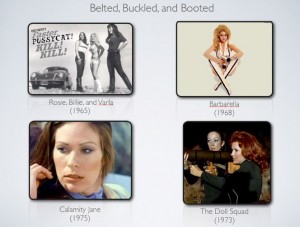
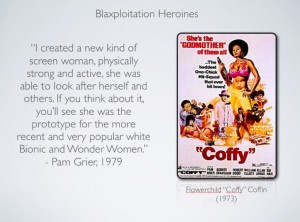
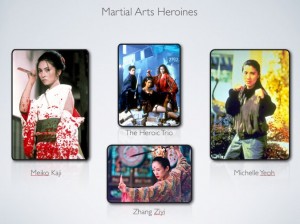
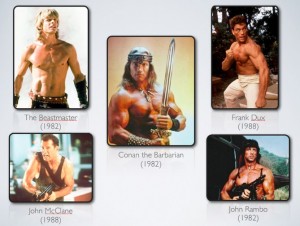
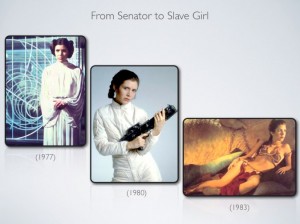

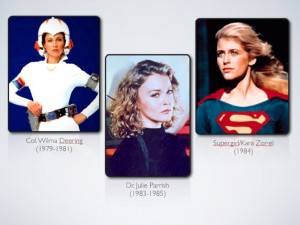
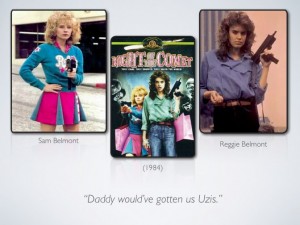
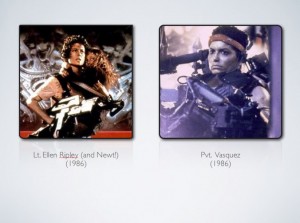
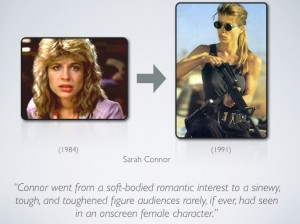
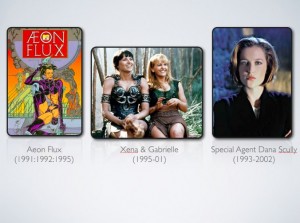
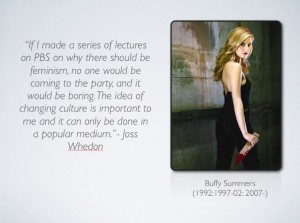
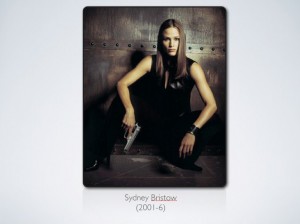
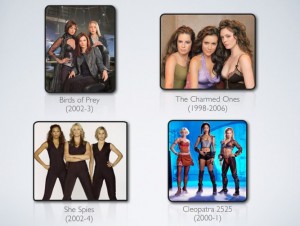
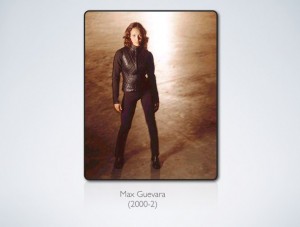

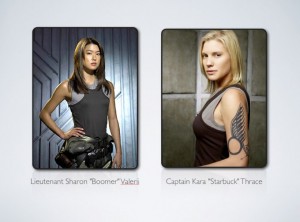
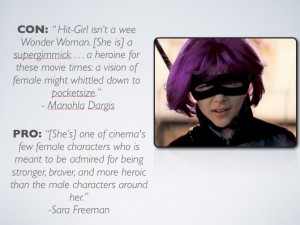
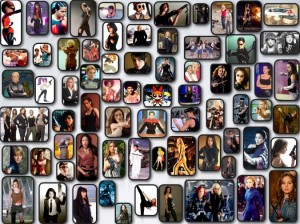
Your presentation was fun and informative. LOVED IT! You obviously could have filled a very interesting hour or more all by yourself. I enjoyed your talk, I’ve enjoyed your Ink-Stained Amazons book, and I look forward to seeing more of you in the future.
All the best!
Katrina
Thanks, Kat! And thank you for arranging a group of such amazing women!